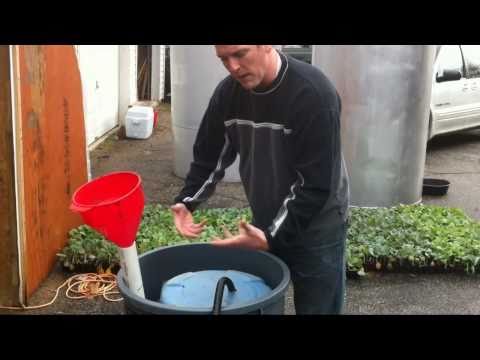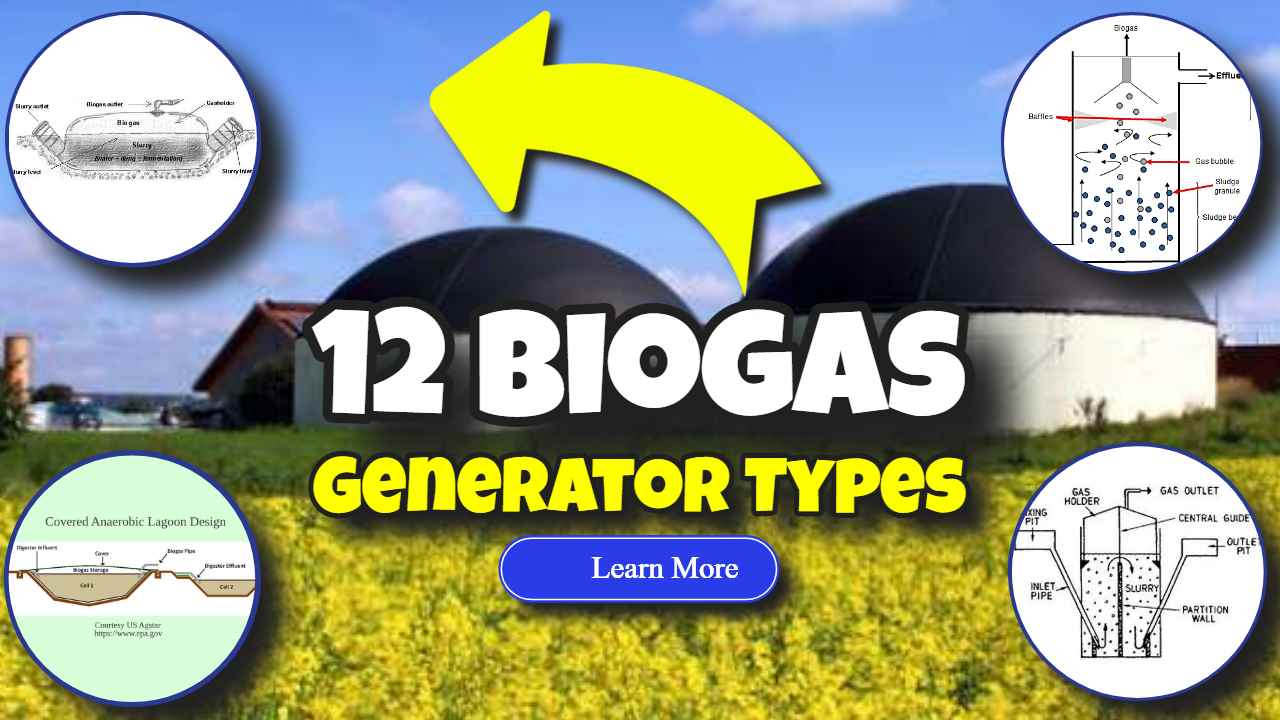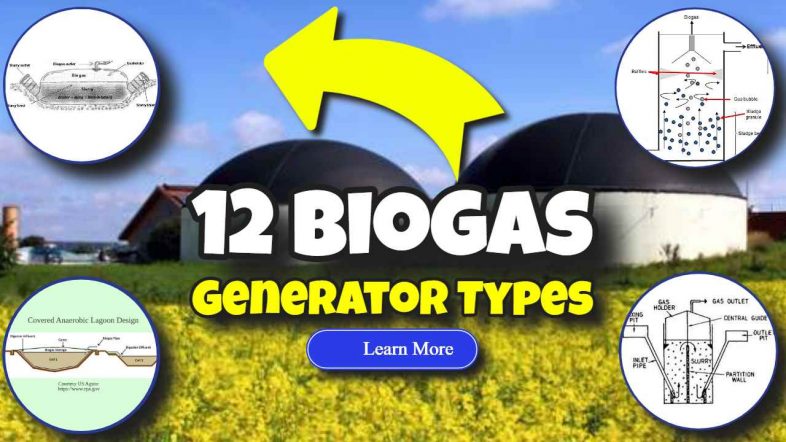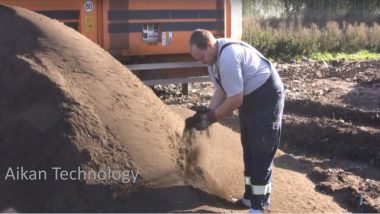Here is our list of 12 Biogas Generator types where we use the word generator as the means by which biogas is generated or created. Some use the word generator to mean an electricity generator powered by biogas, but that's not how we interpret the word “generator” here.
In Europe and increasingly in the US, waste food is being digested in biogas plants – generating biogas!
If not the waste food goes into a landfill and makes landfill gas in the landfill. Landfill gas is, you guessed it! It's BIOGAS!
Most other wealthy nations are just as bad at wasting their food. That means that we all generate biogas (a biofuel) by throwing away organic materials in our rubbish that, once in a landfill, produces biogas.
a) Biogas Generators – Types of Biogas Plants
- Fixed Dome Biogas Plants. A fixed-dome plant comprises of a closed, dome-shaped digester with an immovable, rigid gas-holder and a displacement pit, also named ‘compensation tank'.
- Floating Drum Plants.
- Low-Cost Polyethylene Tube Digester
- Balloon Plants
- Horizontal Plants
- Earth-pit Plants
- Ferro-cement Plants
- Batch plants. via energypedia.info
Plus more (in Part b)!
- Landfill as a Biogas Generator
- A Simple Home Biogas Plant
- Small Farm Scale Biogas Generator
- IBC Tanks Based Generators.
These are the most common applications of biogas technology worldwide.
b) More Types – Landfill Sites, Home Biogas Makers, Small Farm Scale, and Community Biogas Generators
Students: We recommend that you watch our video below, for more about Biogas Generators (they may also be called biogas “reactors”):
Why are many biogas generators underground in Developing Nations? Traditional masonry biogas generators are placed below ground for insulation purposes. The ground is a good insulator, but also masonry walls above ground would collapse when filled with water/ digestate. Masonry/ brick is very strong in compression conditions underground. But try to use the same stone/ brick walls above the ground (not supported by the ground), and they will burst open. That is the main reason why biogas generators are underground.

Biogas is a combustible gas mixture that results from the anaerobic digestion of organic matter in an anaerobic biogas reactor (e.g. small-scale digester, biogas settler, digestion of organic waste, anaerobic baffled reactor, etc). Wastes are treated and degraded during anaerobic digestion, and biogas is produced. Anaerobic treatment also has the advantage of emitting fewer greenhouse gases than aerobic treatment. As a result, biogas is a green, renewable energy source.
9. – Landfill as a Biogas Generator
But, we can ALSO burn Grandpa's trash too, using the gas which pours out of landfills! That's why we say we are all biogas generators.
In 1986 there were over 7,600 small dumps, today there are around 1900 mega-dumps which should have enough capacity for much more garbage yet. We could also call each of these a “biogas generator” because in 2008, power from landfills exceeded solar power production in New York and New Jersey, and biogas collected from landfills has expanded significantly in the years since.
Of the 1900 landfills (or should we call them biogas generators!) over 640 have added the technology to harness the power of landfill gases (LFGs) and convert them to energy. LFG is produced by anaerobic bacteria (bacteria that don't need oxygen) buried deep within landfills.
The anaerobic bacteria munch on our trash and poop out methane which would NORMALLY be real bad for the planet.
Methane is 80 times more potent greenhouse gas than CO2, and according to the EPA, municipal solid waste (MSW) is the third-largest source of human-related methane emissions in the US.
But, if we capture it before it floats up and makes climate change worse, we can use it for good because by using the energy we don't need to use the oil we would otherwise have needed to use.
Methane is an odourless, colourless hydrocarbon (CH4), and because the bacteria are trapped underground, companies can drill wells into the rubbish and suck it out with vacuum pipes.
Once collected, the methane is cooled, cleaned, and mixed with mercaptan to give it a detectable odour before they send it out to natural gas plants to be burned for fuel.
Yep, natural gas normally comes from fossil fuels come from rock, or oil deposits, and depending upon the source it's a “dirty” natural gas. Typically, a mix of 99% methane with some propane, ethane sulphur and helium is mixed in.
The biomass methane also needs cleaning up to be just CH4.
The EPA's Landfill Methane Outreach Program is hoping to encourage companies to set up on top of landfills and suck in as much methane as possible because otherwise, we're just letting dollars float away.
As of 2018, LFG captured energy was powering several million US homes.
So just to recap, we throw away a lot of stuff and just let it sit there, but thanks to these technologies getting trashy could clean up the world.
As found on Youtube.
10 – A Simple Home Biogas Generator

Here is our second biogas generator, and it is using a home anaerobic digestion system to generate biogas.
The whole idea is to create biogas which is such a good green, clean, and sustainable energy methane.
Here, we are going to show you today four different ways. You can go as simple or as high-tech as you want to go with this.
Here is one really simple method right here. You take two cylinders, and as you put food waste and your manure and everything else in there, as you churn it up, the methane bubbles to the top and forces an upper cylinder up, which is good for several purposes.
It holds the methane, and it pressurises the biogas generated. Meaning that you can send it back to your utility gas supply, or whatever you are going to use it for.
You put in your rotten vegetables, and your manure, and whatever organic waste you've got which can be ground up, and you put it in here.
As the methane builds up under this chamber, it raises up slowly, until it would eventually fall off. it won't fall off though because you will use it for cooking. That's why it truly is a great “biogas generator”.
As the cylinder rises up, you turn your cookstove on or your electricity generator. This biogas storage device sinks back down.
In another variation on this generator type, methane and carbon dioxide are produced as food and yard waste decompose, inflating a rubber bladder. As the bladder fills it creates the pressure required to supply a gas burner.
Many household organic “waste” materials can be used to generate your own natural gas for cooking, lighting, and space and water heating.
It is all very simple, and we call it our biogas generator concept.
11 – Small Farm Scale Biogas Generator also for Smallholdings and 12 – Community Anaerobic Digestion (AD) Projects
Next, we are going to do the same thing, for a biogas generator on a much bigger scale.
We got some old fuel tanks from a farm, had them welded together, made one a lot bigger. They just happened to just fit neatly inside each other.
So, here is another concept. Here is a whole other way. The whole idea is to have a sealed chamber that seals off the oxygen.
This is what we have done with three tanks. You put the food scraps, manure etc., in, as before.
But, this time an electric-powered thing grinds them up and sends them down a pipe and the food stays for on average about 30 days where it just rots by fermentation without free oxygen being present.
The digester is at the heart of this biogas generator and must be completely sealed.
The whole idea is to starve the rotting stuff of oxygen to generate biogas. That's what anaerobic composting is all about.
Use products like the Uniseal range to prevent wastage from leaking biogas, during the pilot stage in the storage period.
I am just going to use it. They are not too expensive. We are going to take organic waste, such as rotten apples, and rotten vegetables, and turn them into methane by grinding them up in our methane digester, and letting them rot.
For larger biogas generation plants you can generate biogas at a larger scale. One potential good move (US based) is a 3/4 horsepower in-sink macerator.
I just ground up a whole box of rotting apples in like thirty seconds to a minute, straight into a (past its ‘use-by' date!) apple sauce.
The great thing about using rotten vegetables is you are getting them before it is halfway digested. A lot of people use methane digesters. They will throw cow dung in there, which is good. But, that stuff is halfway already used. The cow has already used it. One time, they hooked up a balloon to one of these cows. That cow, in one day, filled up a balloon full of methane the size of the cow.
But, if your stuff is halfway digested, there is a problem because about half the methane is gone already. If it is fresh it is best. Nothing produces methane better than anything with lots of sugar in it. Cantaloupes, apples etc, produce way more methane than just grass would.
So, what you should do? You should go out to some of the local restaurants, you know the ones right down the street. See if you can make a deal with them to get their leftover food waste to put in your biodigester. It is way better than just using cow dung or chicken waste. There is way more of it.
We went around, and after a while picked up 800 pounds of rotten food waste per load. If it was good, we would feed it to the chickens, but if it is super rotten stuff, we are just tossing in the macerator, grinding it up and mixing it into a digester feedstock substrate (slurry). And it will, if needed, produce methane for seven or eight weeks. It will produce a lot of methane within two weeks.
Then, if it is for waste biogas generation, it just keeps going for about seven or eight weeks.
By the time it is fully digested, the fluid/ solid mix almost comes out looking like a clear liquid.
12. – IBC Tank Based Biogas Generators
These are our three IBC tanks: one, two, three. I wanted to build something that will take a hundred pounds of food scraps a day, move it on through.
The stuff that has been in there for a few days, will come off the top, go back into the bottom, swirl around.
The stuff that has been in here for a couple more weeks, will come off the top.
Then, by the time it gets digested to the end, it is almost fully eaten up and turned into a nice, almost clear liquid. That we can use for fertiliser.
The last thing we are going to do is install our overflow valve. We are going to put a hole and put this uni-seal in right there. Shove it into the tank, and then we can come in and pull off about 100 gallons of fertiliser whenever we want it. We are going to pull off all these burrows and make that really clean. Use a really sharp hole saw if you can.
We recommend painting your biogas generator black, to soak up as much of the sun's heat during the day as possible. That way you can keep that reaction going, and simultaneously use spare heat to warm the farm's greenhouse during the wintertime. Via text article found on Youtube.

Conclusion
We found 12 types of Biogas Generators, including 8 listed on the EnergyPedia! Has anyone found any more? Please comment below, and tell us about a different type of biogas generator if you found one.
Experience we Gained from Running Our Biogas Generators
Alright, now we are going to get into the science of biogas generation at a micro-biological level.
Here is what we found out by accident, because we guess nobody told us, or else we didn't read the last few lines of the instruction manual.
You cannot just throw a bunch of rotten vegetables and rotten stuff and manure or whatever. You cannot just throw it into a chamber and expect it to automatically just create methane. You got several different variables and it is really easy to maintain; you just got to know some of the science.
We do not want to make it sound super difficult, because it isn't. But, the whole idea is you have two different kinds of bacteria.
- One type of bacteria eats your food and creates acid; the other
- eats the acid and creates methane, a methanogenic bacteria.
Then, you have two different kinds of food to feed into the biogas generator. You have:
- low-energy food, like what cows eat, namely grass.
- Then, you've got high-energy food like grain and at the highest levels, you have sugar.
So, what happens is if you put too much high-energy food in your chamber at once? If you feed the system too much, you will end up getting too much acid-producing bacteria or too much acid.
The acid bacteria will go crazy and produce a bunch of acids and that acid is great. It is what the methane-producing bacteria eat to create methane. The problem is it shoots the pH so low.
Once you get below pH 6.0 you are done. Your methane bacteria start to die off and then you have to start over and build back up that methane population.
Several factors influence the relative percentages of methane and carbon dioxide in biogas, including: The carbohydrate, protein, and fat content of the feedstock The digester's dilution factor (carbon dioxide can be absorbed by water).
How do you start a methane digester?
So, the question is, how do you start a methane digester? What is the best way?
The best way is to start it with cow manure. Not chicken manure; chicken manure has way too much high-energy grain, stuff that has not even been digested that just goes right through the chicken's body. But, the cow, they have been eating grass and it is less likely to produce a spike in acid.
Biogas Engines: Another Interpretation
Engines powered by biogas: A combined heat and power gas engine can generate both electricity and heat. Biogas Upgrade CNG / LNG is made from biogas that has been cleaned and separated into renewable methane and carbon dioxide. If gas networks are not available, biomethane can be transported in cylinders.
Includes images from Infopedia.
[First posted in February 2018. Updated January 2022.]






Here, the Welsh and the United Kingdom governments are quite, well, deliberatly ignorant of the technology and it is like a war trying to get the money to build the digesters. actually the welsh can be quite good.
Here in the UK, I and many others don’t get the same government support as farmers do in Germany, France, Sweden or Switzerland to name but a few.
Hello. Unlucky number but very useful info provided here. Power generators drive the globe. It’s true. Thanks.
We have a definition. Check this – biogas generator is a reactor or chemical processing system designed to organically break down biological source materials into gasses such as methane and hydrogen that can then be combined with oxygen for use as a source of fuel.
Thanks for the definition.
Thank you for sharing your article on the 12 different types of biogas generators. Your detailed explanation of each type and its benefits is a valuable resource for anyone interested in learning more about biogas as a renewable energy source.
It is impressive to see the range of options available for biogas generation, from small-scale generators for homes and farms to larger industrial systems.
The advantages of using biogas as a source of energy, such as reducing greenhouse gas emissions and producing a sustainable source of energy, are clear.
Your article is a great example of how innovative solutions can contribute to a cleaner energy future.
Thank you for shedding light on the potential of biogas generation and the numerous options available to promote sustainable energy.